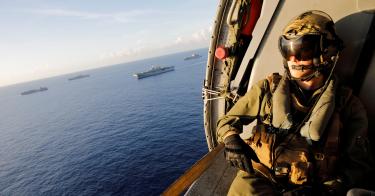In the past few months, the Navy experienced the worst peacetime surface ship collisions in over 41 years.
When the USS McCain and the USS Fitzgerald collided with commercial vessels, it claimed the lives of 17 sailors during routine “independent steaming” operations in the western Pacific Ocean.
These tragic incidents, coupled with the earlier grounding of the USS Antietam and collision of the USS Lake Champlain with a South Korean fishing vessel, have raised significant concerns about the state of the U.S. surface fleet’s readiness and operational proficiency.
Of additional concern is that all of these ships were part of the Seventh Fleet and the Navy’s Forward Deployed Naval Forces (FDNF), whose area of responsibility in the Western Pacific includes some of the busiest shipping lanes in world, as well as the strategically important waters off the coasts of China, North Korea and eastern Russia.
In the wake of the McCain collision, the U.S. Navy quickly responded with several actions.
Chief of Naval Operations Adm. John Richardson ordered a Navy-wide 24-hour “operational pause” or “safety stand down” requiring all fleet commanders and commanding officers to ensure safe operations and identify areas for improvement.
Adm. Philip Davidson, Fleet Forces Command commander, launched a comprehensive 60-day review of surface fleet operations, training and certification of deployed ships with a focus on the FDNF ships.
And finally, Adm. Scott H. Swift, commander of the U.S. Pacific Fleet, relieved the Seventh Fleet Commander, Vice Adm. Joseph Aucoin, due to a loss of confidence in his ability to command.
While these are significant responses, will they be sufficient to alter the wayward course of U.S. Navy surface forces and Seventh Fleet?
Many in the American public have been asking how the “world’s best navy” could suffer such drastic failures in basic seamanship and navigation. Shouldn’t avoiding a collision be relatively simple for a U.S. Navy destroyer equipped with modern technology such as GPS and radars?
While it would be premature to speculate on the specific causes for the recent collisions, as it will be weeks or months before the Navy completes its detailed investigations, there have been significant warning signs of problems within the service and Seventh Fleet in particular. Navy leadership has warned of decreasing fleet readiness due to the high operational tempo of its ships, as well as maintenance backlogs that have resulted in some ships unable to go to sea.
In addition, several recent Government Accountability Office reports, as well as a 2010 Fleet Review Panel on surface force readiness, warned of the impacts of increased deployment lengths, reduced training time, overworked sailors and deferred maintenance on the operational readiness of Navy warships.
The Navy’s investigations will undoubtedly find numerous deficiencies with the crews that ultimately led to the collisions. However, a broader examination of the Navy’s surface forces, and the Seventh Fleet in particular, provides some more far-reaching issues affecting the fleet that contributed to these tragic events.
While recent reports and readiness warnings from Navy leadership have focused on the reduced material conditions of surface ships, it is the surface warfare community’s eroded proficiency in basic seamanship and navigation or “ship-driving” that most likely played a major role in these tragic events.
How did the Navy get to the point where its front-line deployed ships collide while conducting, as Swift stated to his commanders, “the most basic of operations?” Although numerous issues might be at play, there are a few that are arguably the most substantial.
First, the Navy fleet and its sailors are being stretched too thin to meet the insatiable operational demands of the nation and the combatant commanders.
There have also been substantial and detrimental changes to the surface warfare community’s training and professional development over the past 14 years.
There are also unique operational demands and deployment certification of FDNF ships compared to U.S.-based ships.
Another major issue is the impact of eight years of defense budget continuing resolutions and the Budget Control Act on Navy operations and maintenance funding.
The size of the Navy’s fleet and the number of sailors to man these ships are insufficient to meet the ever-increasing operational demand signal of the nation and its military commanders. Even as the size of the fleet has shrunk from 316 ships in 2001 to 277 ships today, the Navy has maintained an almost constant number of ships continuously deployed around the world at 95 to 100.
The Navy has met this demand with a decreasing pool of ships by increasing the length of deployments from six months to, in some cases, nine months or more. In turn, as ships are kept longer at sea, critical maintenance is deferred reducing the material condition of these ships. This leads to extended maintenance periods and increased failure of equipment, placing even greater strain on the ships still able to go to sea.
"‘Ship-driving’ requires significant time and practice to become an expert."
Another impact of this demand/fleet-size mismatch is that the amount of time available for training and assessment of seamanship proficiency is drastically reduced, as mission operations and maintenance take priority. When the ships finally return to port, the sailors are unable to adequately rest and train, as they struggle to complete required maintenance and repair equipment.
The surface fleet and its ships are also undermanned, making it harder for these overworked sailors to find time for training underway and attend professional development courses while in port. In the early 2000s, the surface warfare community implemented an “optimal manning” initiative as an efficiency and cost-cutting measure. The new ship manning levels did not adequately consider the maintenance, administrative and training workload of sailors.
Although the Navy reversed course in recent years and has increased ship-manning levels, current levels are still insufficient for the workload demand on the sailors. This has forced these overextended sailors to prioritize maintenance over training and often sleep in their limited time available outside of their watch-standing duties. The end result is that not only are today’s sailors not as well trained, they are often extremely fatigued, which further degrades their performance.
In 2003, the surface navy made the first of several training and professional development decisions that are just now being felt at the command level. In a move touted as increasing efficiency in surface warfare officer (SWO) career development, but in reality a cost-cutting measure, the six-month surface warfare officer division officer course was closed and replaced by a combination of computer-based and on-the-job training during a junior officer’s first sea tour.
As one would expect, this experiment was a resounding failure, and later replaced by a three-week basic division officer course that can only scratch the surface of the intensive navigation and mariner skills training provided by the original.
With the reduced time underway and in port dedicated to training, these junior officers and sailors cannot develop the required level of seamanship skills to safely drive a ship, especially in the busiest shipping lanes in the world.
In the minimal training time available, the focus is on learning to use modern electronic navigation aids such as GPS, digital charts and radars, not manually plotting a ship’s position, using maneuvering boards to determine relative motion between ships, and an in-depth knowledge of the “rules of the road” — regulations for preventing collisions at sea.
With approximately one-third of a ship’s crew rotating out each year, commanding officers have a daunting task facing them as they attempt to train and qualify these new sailors to stand watch and operate the ship.
Another momentous change in the surface warfare officer career path occurred in 2006 with the implementation of “executive officer to commanding officer fleet-up.” Under this new career path, SWO executive officers serve 18 months and then “fleet up” to commanding officer for their command tour on the same ship. This introduced a couple of significant changes from the previous career path. They are now not assessed and selected for command while still department heads.
Under the traditional path, SWOs would be evaluated as executive officers and then selected for command, providing the surface warfare community leadership a second chance to ensure only the best officers were selected. The new path also means that they will spend up to seven years ashore before returning to sea for their combined executive officer-commanding officer tour.
Like other skills, “ship-driving” requires significant time and practice to become an expert. The first surface warfare junior officers not to attend the six-month officer course will soon be fleeting up as executive and commanding officers. Is the Navy providing these future leaders with sufficient training and sea-time to become expert mariners?
In response to increasing deployment lengths and degrading material condition of its ships, the Navy developed the operational fleet response plan, a 36-month schedule outlining the maintenance, training and certification, and deployment for all Navy ships.
Since the ships based in Japan are constantly forward-deployed, they do not follow response plans, and there is currently no formal process directing the periodic training and certification of these ships across the various warfare missions.
Instead, these forward-deployed ships are often tasked to perform missions based on availability, not mission certification. By contrast, the Seventh Fleet submarine force has established formal requirements and procedures for the periodic deployment certification of its assigned submarines.
Compounding the proficiency issue for forward-deployed ships is their extremely high operational tempo compared to U.S.-based ships. The threat of North Korean nuclear missiles, South China Sea territorial disputes, and other maritime security threats create an unquenchable demand.
As an example, a recent operations officer on a Japan-based destroyer stated that although his ship was scheduled to be at sea 120 days over the course of a year, they completed the year with 250 days underway. It may seem counter-intuitive to some that ships with so many days underway might not be proficient in basic seamanship and navigation. However, the ship’s crew needs sufficient time to conduct refresher training and for commanding officers to assess their proficiency.
A final factor contributing to the Navy’s reduced proficiency in basic seamanship are the impacts of eight years of continuing resolutions and the Budget Control Act or “sequestration.” In striving to meet the needs of the Navy within the reduced funding limits imposed by these legislative actions, Defense Department and Navy leadership have been often forced to cut near-term operations and maintenance funding. This in turn results in more deferred ship maintenance and the reduction of non-mission essential ship underway days.
The result has been fewer ships available for operational tasking and less time for training. Although the Navy has recognized the readiness problem and has prioritized operations and maintenance over buying more ships in its fiscal year 2018 budget, another continuing resolution is looming for the first quarter of 2018. That would at a minimum delay these readiness efforts, as well as any recommended corrective actions that may result from Fleet Forces Command’s comprehensive review of surface fleet operations.
Defense Department and Navy leadership, as well as Congress, must prioritize a refocusing on surface ship seamanship and navigation proficiency and provide its commanders and sailors with adequate time, funding and additional manpower to properly train and assess the proficiency in these most basic and critical seamanship skills.
This piece originally appeared in National Defense Magazine.


